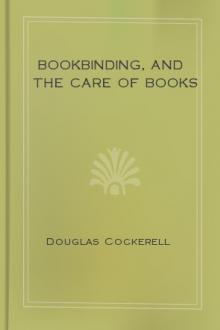Bookbinding, and the Care of Books
Bookbinding, and the Care of Books
A handbook for Amateurs, Bookbinders & Librarians
It is hoped that this book will help bookbinders and librarians to select sound methods of binding books.It is intended to supplement and not to supplant workshop training for bookbinders. No one can become a skilled workman by reading text-books, but to a man who has acquired skill and practical experience, a text-book, giving perhaps different methods from those to which he has been accustomed, may be helpful.
Book Excerpt
remain uninjured (see fig. 1, B). This was all very well for the gold, but a book so treated does not open fully, and indeed, if the paper is stiff, can hardly be got to open at all. To overcome both difficulties the hollow back was introduced, and as projecting bands would have been in the way, the sewing cord was sunk in saw cuts made across the back of the book.
[Illustration: FIG. 1.]
The use of hollow backs was a very ingenious way out of the difficulty, as with them the backs could be made to "throw up," and at the same time the leather was not disturbed (see fig. 1, C). The method of "sawing in" bands was known for a long time before the general use of hollow backs. It has been used to avoid the raised bands on books covered with embroidered material.
If a book is sewn on tapes, and the back lined with leather, there is no serious objection to a carefully-made hollow back without bands. The vellum binders use hollow backs made in this way for great account books that stand an immen
Editor's choice
(view all)Popular books in Instructional, Non-fiction
Readers reviews
0.0
LoginSign up
Be the first to review this book
Popular questions
(view all)Books added this week
(view all)
No books found

 Free Download
Free Download




















